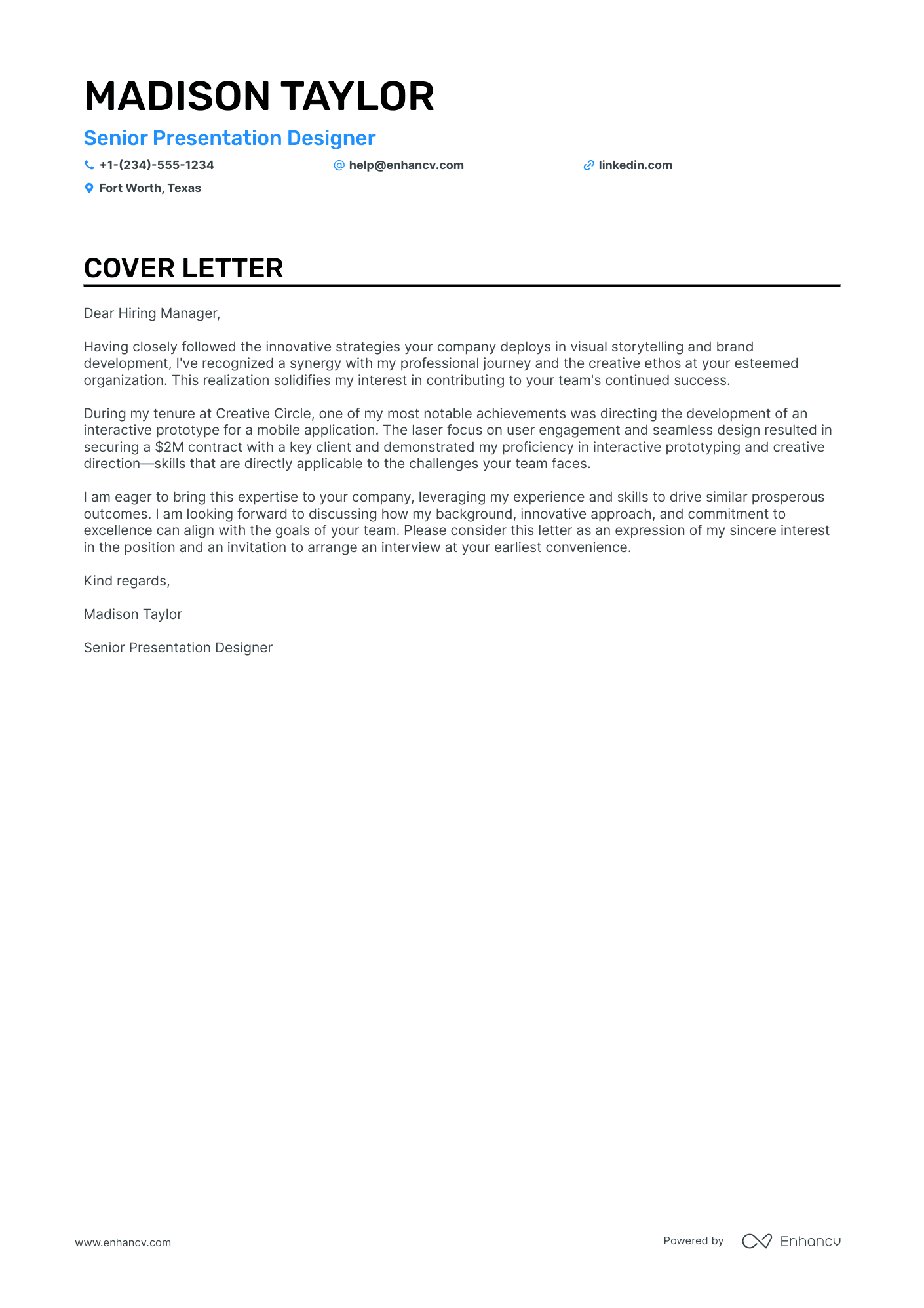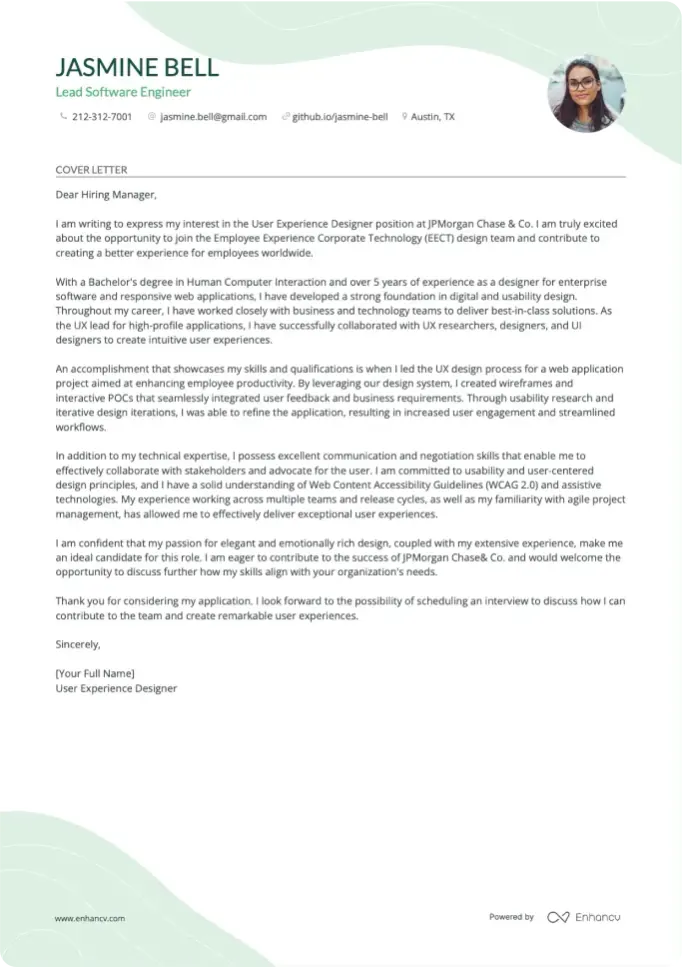Embarking on the journey of an instructional design career, you've tailored your resume and started applying for jobs. Suddenly, you're faced with crafting a cover letter that stands out. It's tempting to rehash your resume, but your cover letter should be a window into your proudest professional moment. It must be a concise, one-page narrative free from clichés and packed with purpose. Read on to learn how to create a compelling cover letter that encapsulates your achievements and reflects your unique story.
- Create a instructional designer cover letter to persuade the recruiters you're the best candidate for the role;
- Use industry-leading instructional designer cover letter templates and examples to save time;
- Dedicate your instructional designer cover letter space to your best achievement;
- Make sure your instructional designer cover letter meets recruiters' expectations and standards.
Avoid starting at the blank page for hours by using Enhancv's AI - just upload your resume and your instructional designer cover letter will be ready for you to (tweak and) submit for your dream job.
If the instructional designer isn't exactly the one you're looking for we have a plethora of cover letter examples for jobs like this one:
- Instructional Designer resume guide and example
- User Researcher cover letter example
- Electrical Designer cover letter example
- Brand Designer cover letter example
- Creative Services Manager cover letter example
- Multimedia Designer cover letter example
- 3D Animator cover letter example
- Logo Designer cover letter example
- Presentation Designer cover letter example
- Design Director cover letter example
- Narrative Designer cover letter example
Drop your resume here or choose a file.
PDF & DOCX only. Max 2MB file size.
Instructional designer cover letter example
Addison Harris
Phoenix, Arizona
+1-(234)-555-1234
help@enhancv.com
- Quantify Achievements: The cover letter demonstrates the effective use of quantitative metrics, such as the mentioned "25% increase in customer satisfaction scores" and "15% increase in learner retention rates," providing concrete evidence of the candidate's impact in previous roles.
- Relevance to Job: It shows a clear connection between the candidate’s past experience and the job they are applying for, ensuring that personal qualifications are matched with the company’s needs and the specifics of the role.
- Skills and Expertise: The cover letter highlights specific skills relevant to instructional design, like the integration of multimedia and simulations, which are desirable in creating effective e-learning experiences.
- Alignment with Company Vision: The letter references the prospective employer’s commitment to innovation in education, showing that the candidate has done their research and understands the company’s goals and how they can contribute.
What should your instructional designer cover letter look like - formatting and organizing your information
Have you ever wondered what are the must-have sections you need to include in your instructional designer cover letter? Our builder sets those up for you with:
- Header - dedicated to your contact information, the role you're applying for, and the date (don't forget to include your name);
- Greeting and opening paragraph - to create a personalized and memorable experience for recruiters;
- Body paragraph - emphasizing your skill set and knowledge that aligns with the role and helps you to stand out;
- Closing paragraph - leaving a great impression and ending with an optional signature.
Use a cover letter template to discover the best formatting for your instructional designer cover letter: that is single-spaced paragraphs and wrapping your content in a one-inch margin.
Ensure that both your resume and instructional designer cover letter are in the same font. Stand apart from the crowd by using modern, yet simple fonts, like Chivo and Rubik, instead of the overused Arial and Times New Roman.
Did you know that the Applicant Tracker System (or ATS) won't be assessing your instructional designer cover letter? Instead, submit your profile in PDF to recruiters to keep the same formatting and the design intact.
No time for a cover letter? Use our free cover letter generator and craft one effortlessly from your resume.
The top sections on a instructional designer cover letter
- Header: This section includes your contact information, the date, and the employer's contact details, establishing the professional format of the cover letter which is crucial for showing your attention to detail and organizational skills as an instructional designer.
- Greeting: Address the recruiter or hiring manager by name if possible to personalize the cover letter and demonstrate your dedication to becoming a part of the organization's instructional design team.
- Introduction: Briefly mention how your experience aligns with the instructional design role, possibly highlighting a key success or project, to immediately draw the recruiter's attention to your relevant background.
- Body: This section should contain two to three paragraphs where you elaborate on your instructional design experience, your understanding of learning theories, and your proficiency with design tools, which are essential skills in this field.
- Closing: It should reiterate your enthusiasm for the role, invite the recruiter to review your portfolio, which is important for instructional design positions, and suggest a follow-up meeting or call to discuss how your skills can benefit their educational initiatives.
Key qualities recruiters search for in a candidate’s cover letter
- Proficiency in Learning Management Systems (LMS): Essential for creating, managing, and delivering e-learning content effectively.
- Expertise in instructional design models (ADDIE, SAM, Bloom's Taxonomy): Demonstrates the ability to systematically create educational programs tailored to specific learning outcomes.
- Experience in course development and curriculum design: Indicates the ability to design comprehensive learning paths that meet educational standards and business goals.
- Strong understanding of adult learning principles: Reflects the capability to create content that resonates with adult learners and maximizes engagement and retention.
- Proficiency with e-learning authoring tools (Articulate Storyline, Adobe Captivate): Allows the designer to produce interactive and dynamic online learning materials.
- Excellent written and verbal communication skills: Essential for articulating design rationale, collaborating with stakeholders, and creating clear instructional materials.
How to personalize your instructional designer cover letter greeting
Before you start writing your instructional designer cover letter, take the time to find out who is recruiting for the role.
Search for the recruiter's name on LinkedIn or the corporate website to address them personally in your instructional designer cover letter salutation.
What if you can't find out who's recruiting for the role?
Always aim to avoid the very impersonal "Dear Sir/Madam" - instead, opt out for "Dear HR Team" or "Dear Hiring Manager" to make a better first impression.
List of salutations you can use
- Dear Hiring Manager,
- Dear [Employer's Name],
- Dear [Department] Team,
- Dear Mr./Ms. [Last Name],
- Dear [Job Title] Hiring Committee,
- Dear [Company Name] Recruiter,
What to include in those first two sentences, or your instructional designer cover letter introduction
Have you ever wondered what the best way is to present your profile in the instructional designer cover letter introduction?
There's no right or wrong answer if you're being concise and authentic to yourself.
Some professionals start their instructional designer cover letter by:
- congratulating the company - focusing on something impressive, whether that's an award, an industry-leading project, or a key event;
- aligning their passion for the field or industry with the job - if you're enthusiastic about what you do, you'd thus grow your skill set and value as a professional.
Structuring your instructional designer cover letter body to add more value
You've hinted at your value as a professional (this may be your passion for the job or interest in the company) in your introduction.
Next, it's time to pan out the body or middle of your instructional designer cover letter.
When creating your resume, you've probably gone over the advert a million times to select the most relevant skills.
Well, it's time to repeat this activity. Or just copy and paste your previous list of job-crucial requirements.
Then, select one of your past accomplishments, which is relevant and would impress hiring managers.
Write between three and six paragraphs to focus on the value your professional achievement would bring to your potential, new organization.
Tell a story around your success that ultimately shows off your real value as a professional.
Ending your instructional designer cover letter: a closing paragraph with a promise
If you're thinking of finishing your instructional designer cover letter with a "Sincerely yours" or "Thanks for the consideration," you need to read on.
End the final paragraph of your instructional designer cover letter with a twist:
- a promise - of how you'd grow as a professional, part of the company, or improve organizational metrics;
- a call to action - prompt interviewers with some follow-up actions if they are interested in your profile.
A personalized ending would surely help you to stand out by being a memorable candidate.
Instructional designer cover letter advice for candidates with no experience
If you're worried about writing your Instructional Designer cover letter and have no professional experience, we sure have some advice for you.
Turn recruiters' attention to your transferable or relevant skills gained thanks to your life and work experience.
Instead of writing about past jobs, focus on one achievement (whether from your volunteering experience, education, etc.) and the skills it has helped you build.
Alternatively, you could focus your Instructional Designer cover letter on your career objectives and goals. Always remember to make those relevant to the job you're applying for by detailing how you see yourself growing as part of the company.
Recruiters would be way more impressed with candidates who fit the job profile and can bring about plenty of skills and vision to the table.
Key takeaways
Creating your instructional designer cover letter should be a personalized experience for the role and the recruiter, where you:
- Format your cover letter using the same ATS-friendly font (e.g. Railway) as you did for your resume;
- Greet recruiters, using their name, and follow up with two sentences to introduce yourself, your interest in the role, and to stand out;
- Map out one key success from your career (or life) that has taught you job-crucial skills;
- Substitute your lack of experience with an achievement from your internships, degrees, or volunteering gigs;
- End with a promise for your potential or your availability for an interview.
Instructional Designer cover letter examples
By Role






